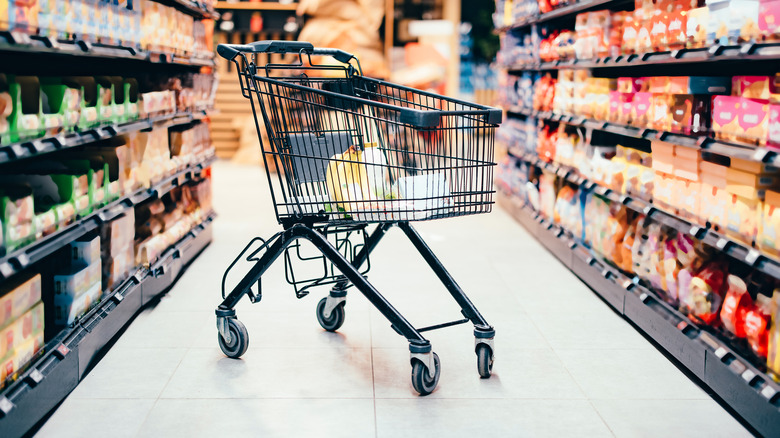You're Not Wrong, Shopping Carts Are Bigger Than Ever
Shopping carts haven't always been big. The first shopping cart model, created in 1936, was essentially two baskets on wheels. Before then, there was no need for carts, because for a long time, grocery stores didn't even have shoppable aisles. Customers would just ask for whatever goods they needed, and an employee would retrieve it for them.
As the landscape of grocery stores evolved, so did the carts. In 1962, the concept of a superstore — a place where you could buy both food and other merchandise under one roof — was first born. To this day, you'll notice that places like these, for example, Walmart and Target, typically have much larger carts than, say, Trader Joe's, which doesn't sell the same breadth of products as superstores and has smaller aisles.
Grocery stores aren't exactly continuing to evolve, at least not as much as they did in the 20th century, yet shopping carts are still getting bigger. In fact, they are almost three times the size they were back in 1975. But why is this the case?
Why stores are increasing the size of shopping carts
The reason stores are increasing the size of their shopping carts isn't to facilitate a better customer experience. It has more to do with profit. The size of a shopping cart is proven to correlate to how much people are willing to spend at the store, and businesses use this to their advantage, marketing expert Martin Lindstrom told Today. If their shopping cart is doubled in size, people typically spend 40% more whether they realize it or not.
In addition to the general size of the shopping cart, retailers are also starting to modify the overall design for the same reason. A newer design of shopping cart, already rolled out in some U.K. grocery stores, features two separate handlebars, one for each hand, forcing you to push the cart similar to the way you would push a wheelchair. According to a study conducted by Bayes Business School, this seemingly simple handle repositioning causes customers to spend 25% more on their groceries.
Consider ditching the shopping cart
If the first thing you do anytime you go to a grocery store is reach for a cart, you may want to consider changing your approach. Instead, try to opt for a basket whenever you can. If the items on your list can fit just fine in a basket, grabbing a cart may not be the best idea because it could easily lead you to buy more than you actually need.
For bigger shopping trips, the smaller, two-tiered shopping carts, commonly referred to as "millennial shopping carts," also tend to be a better option. Similar to sticking to a basket, these smaller carts encourage people to only buy what's on their list, or at least limit themselves to what fits in their cart. Unless you're planning to stock up on groceries or buying in bulk at a warehouse store like Costco, using the giant shopping carts that have become increasingly popular probably won't do you any good.


